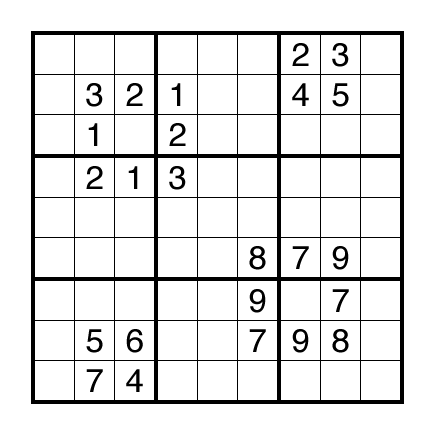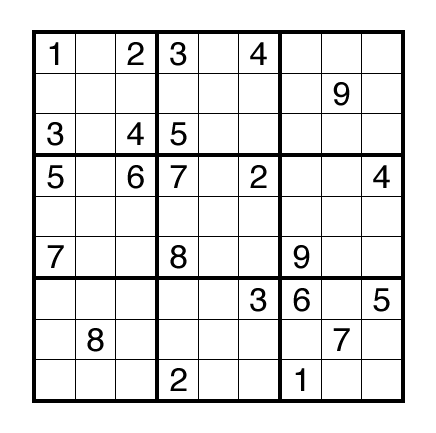(Older) Championship Chatter – Sudokus and Such
While scheduling the month of June for the site, and considering the potential for some likely downtime or errors while changing web hosts, I budgeted two weeks for recent US championship puzzle discussion. For this week, I’ve planned to cover the US Sudoku Qualifying Test (also the sixth leg of the Sudoku Grand Prix). If you are desperate for new puzzles, those will arrive next Monday at their usual time. But there may be some new challenges revealed throughout this week during the discussion of these creative sudoku.
I figured I’d give a general overview of our design process at the start. As with past years, we (Nick Baxter, Wei-Hwa Huang, and myself) had planned a two-part championship with Classics and near classic variations for the first part, and mostly new or less common styles for the second part. Some of this has been to gauge relative solving capabilities on the challenges that might appear at a WSC, and some of this has been for our own sanity checking of potential competitors. There are more web-accessible sudoku solving tools that can handle “part 1” puzzles and some unbelievable times have been posted there in the past. But less familiar or original styles in “part 2” will challenge anyone solving with certain types of assistance. After the 2009 experiences in Philadelphia at our last live national championship, we know to be extra cautious.
While having two parts was the original plan, the requirements of the Grand Prix changed our design mid-stream and a single big round was used instead. So solvers got 2.5 straight hours of solving to test their mettle. But you can see that the ordering of the puzzles still naturally splits the first ten from the last ten and perhaps many solvers found themselves focusing on just the first part instead of the other.
We like having a mix of puzzles but also a fair number of classic sudoku since a sudoku championship should certainly test the fundamentals. I wrote all 4 of our classic puzzles, each somewhat noteworthy in its own way. Their numbering was maintained in my “construction order”, as testing revealed their mean solve times were within a minute of each other and they would all receive the same point values on the test. I believe only solvers with a very broad skill set would have a uniform performance on the entire set. But just as different test-solvers reported being tripped up by different puzzles, competitors reported the same thing with #2 and #4 seeming to be outliers. I wonder what your experiences were?
I’m posting the first two classic puzzles below, with design spoilers concealed after each puzzle. The next two classics will follow tomorrow.

or solve online (using our beta test of Penpa-Edit tools)

or solve online (using our beta test of Penpa-Edit tools)
Themes: Both geometric and logical
Answer String: For the USSQT, the answer strings were a set of rows/columns encountered late in the puzzle. For this week, you can just hit the solved button on an honor system if you think you’ve solved it.
Design Notes (highlight to view): The first puzzle was designed around a low/middle/high separation and has large squares made out of 1-3 and 7-9 only that provide some symmetry along the solve. For example, consider the 1 in the upper-right corner and the 9 in the lower-left corner which come from looking horizontally, followed by either 79 or 12 pairs to finish those border columns from looking vertically each allowing the last two numbers in the corner regions to be identified. This is probably the easiest of the four classic puzzles but not by much. The second puzzle was designed to require good use of pointing pairs, particularly in the upper-left boxes, involving the “8” and “9” that are lone digits. A relay of these pointing pairs through two boxes should place the first 8s and 9s that cascade to give several other digits.

Yeah, I definitely saved these for last during the competition. I’m pretty sure my relative speed on classics makes that a good choice for me compared with other puzzle types. They’re also a lot easier (for me, anyway) to quickly decide “I am making progress” or “I am stuck” to choose a puzzle that I can almost certainly solve in the last few minutes.
During the test, #2 was definitely much more challenging for me than any of the others. It gave me the “I am stuck” sign and I moved on to the rest of them. Afterwards, solving it in a more relaxed time, I still spent way too long finding the way to start making progress, so I’m glad I made that decision.
This is the kind of thing that I’m getting much better at when I practice solving without notes; that tends to be a lot slower in general, especially on harder classics, but to focus me much more effectively on seeing things like this when they come up. I still have a long way to go on these, though!
It’s too long ago to remember details about most puzzles, but I remember I found the point distribution very weird across the board. I actually wondered, if there had been any test solving times at all. Only specific example I can give right now is the Tight Fit, that felt very undervalued.
There was some “smoothing” so everything was out of 5, 10, 15, … points but there were 4 test-solvers in the data. It definitely was the easiest puzzle by time, but again with all of these puzzles we’d have an outlier with one tester sometimes and it is hard to gauge if it is because their search process is different or they just have less experience with the style or not. We certainly all have a lot of Tight Fit Sudoku experience having made the type and a whole book of them.
I agree that the Tight Fit was more than half of a 10-pointer for sure, probably closer to equal to one, despite having solved most of that book prior to the competition. And I think I’m relatively slow in the classics so those 10-pointers were already probably a bit slow for me.
A couple of the 20s seemed closer to double the 15s than double the 10s, too, but that was most true for the Seek-And-Spell which I know is a type I haven’t practiced much, so it might just be my own inexperience showing there. Though I loved the Whovian examples here!
For what it’s worth, while I realize the main reason for abandoning the double-round format was the GP, I was really happy with the change. The part of any online puzzle competition I find most stressful is printing… is my printer going to jam? Am I going to have trouble with loading the password? It requires me to be in a very different frame of mind than I am when solving, and I hate having to temporarily change processes in the middle of the test. I realize that security concerns may cause you to go back to the old format next year, but consider this an emphatic vote in favor of a single test file.